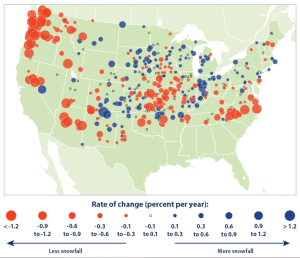[Last update: October 2025]
Quick Links to Topics Covered in This Article:
INTRODUCTION • Seasonal Recommendations for Tree Planting
INTRODUCTION
Times have changed in Midwest America, and we’re not talking about clock settings. Our summers are hotter, and we experience more frequent droughts, while warmer overall temperatures result in less precipitation falling as snow and more as rain.
Data collected from nearly eight decades, since 1930, by the U.S. Environmental Protection Agency (EPA) indicates a change in total snowfall in the country. A warmer atmosphere can hold more moisture, but higher temperatures mean winter precipitation is more likely to fall as rain. In some cases, a cycle of drought can cause warmer soil to absorb more solar radiation, creating high pressure that further suppresses rain and exacerbates heat.
The best time to plant new trees is late fall or early spring when temperatures are moderate. This allows the tree to establish a strong root system before extreme summer heat or winter freezes. Planting during a tree’s dormant season in the cooler, wetter months is ideal because it is less stressful for the tree and allows it to focus energy on root development. In tropical climates, planting is best done right before the rainy season starts.
- Late fall/early spring: This is the ideal time for most climates because the soil is still warm enough for root growth in the fall, and cooler temperatures in the spring prevent the stress of hot summer weather. This allows the tree to establish itself for several months before the next summer’s heat arrives.
- Late winter: If planting is delayed until winter, the tree is still dormant, but care must be taken if the ground is frozen.
- Summer: This should generally be avoided due to extreme heat and drought, which can stress the tree and hinder root establishment.
- Tropical/subtropical climates: Plant right before the rainy season begins to take advantage of natural watering.
Important Factors:
- Soil test: Get your soil tested to guide your tree selection.
- Tree type: Evergreens, for example, are often better planted in the spring because they continue to lose water through their needles all winter, which can lead to dehydration when the ground is frozen.
- Water availability: Ensure adequate watering after planting. Planting during a period of regular rainfall can significantly help the tree establish itself.
- Adapt to local conditions: Extreme weather patterns make it crucial to adjust planting times to your specific region’s conditions.
- Focus on resilience: Planting during the optimal moderate, wetter periods helps trees better adapt to changing climate conditions, including intense heat waves and droughts.
- Choose appropriate species: Selecting tree species that are well-suited to your local climate and the projected future climate is a critical component of successful tree planting.
Are you ready to plant your new tree?
Here are some helpful tips on How To Plant A Tree (See additional resources below.)
- Purdue University Publications & Videos
-
-
- “Consumer Horticulture: Collecting Soil Samples for Testing” https://mdc.itap.purdue.edu/item.asp?Item_Number=HO-71-W
- “Tree Planting Part 1: Choosing a Tree” https://mdc.itap.purdue.edu/item.asp?Item_Number=FNR-538-WV
- “Planning the Tree Planting Operation” https://mdc.itap.purdue.edu/item.asp?Item_Number=FNR-223
- “Tree Planting Part 2: Planting Your Tree” https://mdc.itap.purdue.edu/item.asp?Item_Number=FNR-540-WV
- “Tree Pruning Essentials” https://mdc.itap.purdue.edu/item.asp?Item_Number=FNR-506-W
- “Tree Pruning: What Do Trees Think?” https://mdc.itap.purdue.edu/item.asp?Item_Number=FNR-534-W
-
- Indiana Department of Natural Resources (INDR/CUF) Community & Urban Forestry https://www.in.gov/dnr/forestry/2854.htm
- ISA “Planting Details and Specifications” https://wwv.isa-arbor.com/education/onlineresources/cadplanningspecifications


